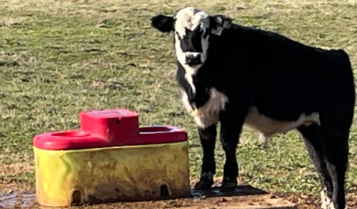

Dr. Andrew Griffith
Assistant Professor
Department of Agricultural and Resource Economics
P: 865-974-7480
By this time of year, humans and cattle alike are feeling the heat. People that work outside are looking for a reason to soak up the air conditioner or find a creek to stick their feet in while cattle are standing under trees or in ponds to cool off. Despite being in the midst of summer’s physical heat, that is not the only heat cattle producers are feeling right now.
The other types of heat cattle producers are experiencing is if there will be enough hay to feed cattle this winter, if there will be enough money to pay all the bills due at the end of the month, and if cattle prices will ever increase. The economic environment has sent input prices skyrocketing as well as other goods. However, cattle prices have made no such move. This situation has resulted in more money going out relative to the quantity of money coming in. The bank account dwindling to nothing is comparable to 95 degree temperatures and humidity so high that a person drowns when breathing. This is further compounded by a short hay crop due to reduced fertilizer application and simply poor growing conditions. This brings on the decision of purchasing feed or selling cattle to settle debts and ensure adequate feed to get cattle through the winter.
This quantity of pessimism can cause recurring mental pain, and the situation is not worth that. First, there is no need to complain about these struggles that cannot be controlled as that simply adds to the disgruntlement. What needs to be focused on is finding a solution or solving the problem. The easy solutions are to purchase more feed if ample capital is available or to sell cattle if not enough capital is available. However, these may not be the best solutions. Some alternative solutions may be to find underutilized acres that can be grazed or hayed or to sell all the cattle, lease out pasture and sell hay to someone else who needs those same resources. These solutions both sound difficult, but they may be more profitable than the alternatives.
Some readers may have more creative methods than what is outlined here, but the key is to figure out what works for the system and make a move sooner rather than later. The next thing is to determine how to avoid being placed between a rock and a hard place again, which may take the form of reducing stocking rates, reducing reliance on purchased inputs, and simply trying something different than what has always been done.
Now for the uplifting part of this article. The current situation may not be bad or it may be terrible, but there is one guarantee and that is that it will not last forever. The times of extreme struggle can test one’s character, but if one perseveres through the struggle then they build and prove their character. If approached correctly, it will build endurance and provide hope for a better day. When those better days come, they will be great because of the rawness of the previous days.
By the time this article reaches readers, the conditions that cattlemen face may be different than what they are on the day I am writing this. Frankly, I hope this hits deaf ears because cattle prices have increased, fuel and fertilizer prices have decreased, and forage is plentiful. However, I think it wiser to prepare and plan for tough times with the hope of good times. It was once said that a man should carry a stick when walking through the woods in case of a bear attack. A high-powered rifle makes more since though.
In closing, producers should prepare each and every year as if it is going to be a lean year with regards to forage, profits, and anything else. One can manage through high fertilizer prices or drought if they do not overstock their pasture. One can manage through high input price times if they find methods to manage an operation with less dependence on those inputs. Foresight cannot prevent every obstacle, but preparation for common and familiar challenges can give a weary mind rest.